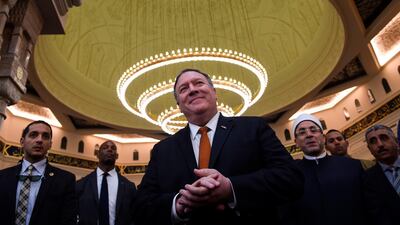From recent statements by Donald Trump, his national security adviser John Bolton and Secretary of State Mike Pompeo, it is possible to begin piecing together what the new US policy in Syria might look like if American troops do actually depart.
The US began withdrawing military equipment from Syria over the weekend, ahead of the expected withdrawal of its estimated 2,000 troops.
The timeline is ambiguous: Mr Trump has suggested it will be sooner, Mr Bolton that it might be later. But unless something dramatic changes – always a possibility with this White House – the removal could be a matter of months.
What the US wants to achieve after the withdrawal – which Mr Pompeo described in the UAE last weekend as merely a “tactical change” – is to continue to attack ISIS (but only from the air, as the secretary of state made clear), expel “every Iranian boot” from Syria (but without keeping troops on the ground), and protect the Kurds from Turkey (but only through non-military, economic pressure).
The threat to apply that economic pressure has already caused a row with fellow Nato member Turkey. Mr Trump fired off a tweet on Sunday, threatening to "devastate Turkey economically if they hit Kurds", prompting a televised rebuke from Turkey's foreign minister, Mevlut Cavusoglu. It was a dispute that highlighted how hard it will be to find common ground in Syria, even with allies.
The overall impression, then, is of a hands-off strategy, one where the US would use economic and political pressure, plus the help of allies, to enforce its policy. In a phrase, it boils down to American leadership from the air.
The crucial problem, though, is that the strategy conflicts with the policy.
The goals Mr Trump wants and the means he is willing to use to achieve them are at variance. Either the policy needs to shift or the strategy needs to change. America's allies will be concerned that, with Mr Trump seemingly still determined to remove US troops, it is the former that will change.
The US has three main objectives in Syria: defeat ISIS, protect its Kurdish allies and curb Iranian influence. Those are in ascending order of difficulty.
Once US troops leave, all three objectives will rely on others to be achieved. Yet only on the first is there broad agreement in the region. The rather narrow goal of defeating an expansionist ISIS is, unsurprisingly, backed by all the governments involved in Syria's war.
But when it comes to protecting the Syrian Kurds and pushing Iran out of Syria, there are powerful forces committed to opposing US policy.
Turkey has made clear for years its objection to the Syrian Kurdish militias on its border, which it maintains are allied with the militant PKK group operating inside its borders. Ankara has spent millions of dollars and shed the blood of its soldiers to stop the Kurds acquiring contiguous territory across Turkey's southern border. The one thing that has given them pause has been the presence of US troops – and only pause, because Turkey in the past has threatened to attack positions where US soldiers are present.
The idea that, with US troops gone, Ankara would stop its policy simply because of Washington's desire – or because, as Mr Trump tweeted earlier this week, the US has threatened economic pain – is fanciful. Denying Kurds in Syria the ability to co-ordinate with Kurds across neighbouring borders is more than a policy for Turkey – it is a pillar of foreign policy.
America's third objective will be the hardest to accomplish.
Expelling "every Iranian boot" from Syria would have been extraordinarily difficult even if US troops were to stay. With the troops gone, it would be almost impossible without a concerted effort by an organised military.
Since not every country bordering Syria wants the same end – the rest are prepared to tolerate Iran's presence or have their own, more pressing aims – it is not clear who will provide that military.
Even Israel's ability to target Iranian military bases within Syria was heavily curtailed when a Russian aircraft was accidentally shot down in September by Syrian anti-aircraft fire trying to block Israeli missiles. In the immediate aftermath, Russia supplied Syria with the S-300 surface-to-air system. Israel was forced to halt all airstrikes but has since resumed occasional attacks.
It begs the question: with US troops gone, will America be able to persuade Arab countries to put their own troops in harm's way to satisfy its objectives? And will the Syrian regime allow them to do so? At best, the answer is ambiguous.
All of which means that the US will need to find other countries willing to push America's policies, a difficult ask in a region with so many competing interests – and not merely push policies but if necessary, defend them with military force.
That is the crucial part of the strategy that has not yet been explained or else has been missed out entirely. Where, in the next few months, can such a force come from?
And that tight timeline matters. Because as soon as US troops leave – indeed, as soon as they begin to vacate positions – others will move in to fill the vacuum. Once US troops draw down in earnest, the timeline before some of the US objectives begin to unravel will be measured in weeks.
Without being there on the ground, the US will rapidly find the priorities of its allies are not its own. Leadership from the air, and policy by fiat, will not work.
Either Washington needs to be prepared to defend its policy goals by force, or it must accept – and its allies need to prepare for – those goals to be discarded. In the tangled politics and crowded battlefields of the Middle East, there is no middle way.
American leadership from the air can only work if there are someone else’s boots on the ground.


